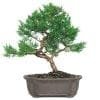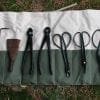Introduction To Pre-Bonsai Trees
Pre bonsai trees are the best option for you if you’re looking to grow a bonsai tree from the ground up into the shape and form that you want. A true bonsai is hand picked when it is young. It is cut out from the ground and potted, then nurtured for years to obtain a final, perfect shape.
A pre bonsai tree is a tree that has been partially trained. It hasn’t reached its final form and is still open to additional shaping and training. Some of these are sold unpotted because they are meant to give the new entrant to the bonsai growing scene additional options for customizing their bonsai tree.
One good thing about pre bonsai trees is that they are sold cheap. Since not much effort has gone into turning them into the perfect version of themselves, there is no additional price heaped upon them.
However, this does mean a good amount of effort and years of training will be needed on your part to form a fully trained bonsai tree that will beautify your garden like never before.
Here are some quick tips for choosing and growing your favorite pre-made bonsai trees after you have bought them:
Tip #1: Plant them in the ground for faster growth
All trees love the ground. They love the feeling of the soil and fare far better in the bare ground than in the soil of a small pot.
However, you should realize that at first, the rate of growth is going to be far lower in the ground than in a pot.
This is because, in a pot, the growth of the roots of the tree is restricted by the confines of the pot. Pre-made bonsai trees experience this because they are typically still in the growing stage.
Since the roots don’t grow, the top grows at a faster rate. However, this does even out as the tree gets older.
Tip #2: Select the species
Before you buy a pre bonsai tree, ensure that you know which species you want. According to your lifestyle, you’re going to be able to afford different levels of care for the bonsai that you get.
Consider where you will grow the tree too, whether inside or outdoors. Think about the atmosphere of your location (tropical, arid?).
If you happen to buy a premade bonsai tree that isn’t made for the tropics, ensure that you grow it away from high levels of sunlight and humidity.
Tip #3: Shape and style
Bonsai tree growing is all about creativity. A pre bonsai tree is a rough outline of what could be a beautiful addition to your home or garden. Whether you manage to get it there is entirely up to you.
Over the course of nearly a century or more, the art of cultivating and shaping a bonsai tree has evolved into something that is far more than merely gardening.
By wiring and restricting the trees in order to keep them small and gorgeous, a lot of pruning and other tactics are necessitated.
While you can definitely learn the basics easily, more advanced cultivation techniques take years to perfect, and some can’t be learned without the help of a master.
Tip #4: Have patience
Since you’ll be growing a premade bonsai tree, you will have to face two facts. One is that the price of a pre-made bonsai is more affordable than a normal one.
The second is that this cheap tree comes at a cost – you will need patience if you want to see results. This isn’t a race to get the prettiest tree in the shortest amount of time.
There is no endpoint to the journey that you embark on with your first pre-bonsai tree. You simply go on and on, constantly pruning it, shaping it and caring for it until the tree is at one with nature.
Tip #5: Be careful with your wires
Wiring is one of the most common ways to shape the pre bonsai trees you buy. You can wrap wires around the trunk and branches as it grows, causing them to bend over time.
While this isn’t some extreme form of bending, it can be very beautiful if done right. However, you do have to remember to remove the wires as soon as it looks like there is scarring on the branches.
Do not leave your wires on for too long, and don’t wrap them so tightly that the tree is constricted.
Caring for Your Pre-Bonsai Trees
Bonsai trees are one of the most demanding plant types in terms of the amount of care that they need. For example, watering one doesn’t mean you can go ahead and pour as much water as you want.
You have to think about the species of the tree, the soil in the pot and even the climate. A pre bonsai tree needs more care too because it is still growing and being trained.
Repot your tree regularly, at least once in two years, and ensure that the roots are free of the walls of the pot. Don’t just water your pre bonsai tree once a day.
Check on the quality of the trunk as well as the moisture in the soil. Also, make sure that all the water you put into it is absorbed completely without remaining on the top layer of the soil.
The last thing to keep in mind is that fertilization is incredibly important. Since the pots that pre bonsai trees come in are small, and some of them are unpotted, you have to ensure that the soil in the pots is fertile.
Adding fertilizer is the best way to keep your trees healthy and growing well. The type of fertilizer doesn’t really matter.
With these tips in mind, go forth into the world of bonsai growing. Take your premade bonsai tree and turn it into something beautiful. Remember that patience and time are the most important factors that affect the quality of your growing task.
Flowering Brush Cherry Bonsai Trees
This is the pre bonsai version of the beautiful Australian Bush Cherry tree. This is a tree that is a great addition to your indoor garden. It is an evergreen, and with the right amount of care will grow to have some beautifully glossy and firm leaves.
In the summer, the patient bonsai nurturer will get to enjoy white blooms that truly are a sight for sore eyes. With enough sunlight during training, a fully trained Bush Cherry tree will start to show red highlights on the flowers and the blooms.
You should opt for a pre bonsai tree that is about 3 years old and 8” tall for the most options while growing. A great example of this type of premade bonsai tree can be found here.
Shimpaku Juniper Bonsai Tree
This is another version of the Karate Kid Juniper tree which is also native to Japan. However, this variant species is unique in that it has separate trees that are either male or female.
The tree is typically shaped like a vase and can be trained in the classic “coiled trunk” style. While it is true that a trained tree looks naturally amazing in this style, it might take your far longer to perfect it on your own.
However, you are bound to enjoy growing the Shimpaku pre-made bonsai tree. In time, it is going to look incredible. One of the biggest perks is that it is one of the easiest trees to care for.
Look for a tree that is about 3 years old and not too tall, like this one right here.
Ficus Retusa Bonsai Trees
The Banyan Fig is one of the more popular bonsai trees because of its gorgeous leaves, which are small, green and go all the way up the trunk of the tree.
While the partially trained variant isn’t all that great to look at, you should train it well for the best results over time. A trained fig tree has a gorgeous gray and red bark that has little flecks on it that make it look a little like a tiger.
The trunk is quite large, and the roots tend to be exposed as well. It is, however, one of the easiest bonsai trees to care for, especially when used indoors. The best trees are about 8 years old and can be found right here.
Juniper “Karate Kid” Bonsai Trees
Have you ever seen the Karate Kid? Not the one with Jayden Smith, the original. The bonsai tree was a major part of the movie. The species was the Juniper, a native to the island country of Japan.
It is one of the most popular types of evergreen bonsai trees in the USA. Do you know that vision in your mind’s eye of what a proper bonsai tree looks like? The image is probably the juniper.
You can buy this for a very affordable price right here and is definitely one of the best trees to take care of. Look for one that is about 3 years old and 4” tall.


